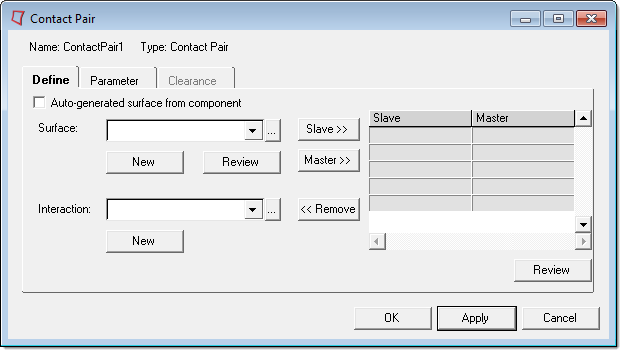Contact Pair: Define Tab |

|

|

|

|
|
Contact Pair: Define Tab |

|

|

|

|
The Define tab allows you to select the slave surface, master surface, and surface interaction for the *CONTACT PAIR card. You can also review the selected surfaces or create new ones.

The Define tab contains the following options:
Auto-generated surface from component |
Select this option for Engineering Solutions to automatically generate *SURFACE cards from a selected component. When this option is selected, the Surface: field becomes a Component: field, and you can select a component from the adjacent drop-down list. Click Slave>> or Master>> to add them to the table of included surfaces as slave or master, respectively. |
||
Surface |
The Surface: field contains a list of the existing surfaces. Select a slave surface from the list or use the … button to open the Entity browser to select a surface. Click the Slave>> button to add the surface as a slave to the table of selected surfaces. Click the Master>> button to add the surface as a master. Click Remove>> to remove any selected surface from the table. You can add multiple sets of surfaces to the table. Click the New button to create a new surface. Once you have specified the surface properties, the surface appears in the drop-down list, where you can select it and add it to the table. For a description of defining surfaces, see Element Based Surface or Node Based Surface. The Review button highlights the selected slave surface in red and displays it through solid mesh in performance graphics in the Engineering Solutions window. If the surface is defined with sets, the underlying elements are highlighted. Right-click on Review to clear the review selections. |
||
Interaction |
The Interaction: field contains a list of the existing surface interaction properties. You can select a surface interaction from the list. You can also use the (…) button to open the Entity browser to select a surface. The New button opens the Create New Surface Interaction dialog for creating a new surface interaction. When the new surface interaction has been defined, the Contact Pair dialog reflects the newly-created surface interaction as the interaction of the contact pair. For a description of defining surface interactions, see Surface Interaction.
|
Note that if you create multiple pairs of contacts, they will appear on the Interface tab in separate entries using the same name.